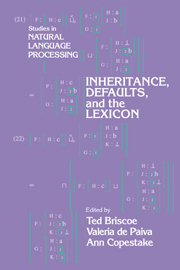Book contents
- Frontmatter
- Contents
- Contributors
- 1 Introduction
- 2 Skeptical and Credulous Default Unification with Applications to Templates and Inheritance
- 3 Prioritised Multiple Inheritance in DATR
- 4 Some Reflections on the Conversion of the TIC Lexicon into DATR
- 5 Norms or Inference Tickets? A Frontal Collision between Intuitions
- 6 Issues in the Design of a Language for Representing Linguistic Information Based on Inheritance and Feature Structures
- 7 Feature-Based Inheritance Networks for Computational Lexicons
- 8 A Practical Approach to Multiple Default Inheritance for Unification-Based Lexicons
- 9 The ACQUILEX LKB: An Introduction
- 10 Types and Constraints in the LKB
- 11 LKB Encoding of Lexical Knowledge
- 12 Defaults in Lexical Representation
- 13 Untangling Definition Structure into Knowledge Representation
- Appendix A A Bibliography of ACQUILEX Papers Connected with the LKB
- Appendix B The LKB Description Language Syntax
- Appendix C Software Availability
- References
- Author index
- Subject Index
12 - Defaults in Lexical Representation
Published online by Cambridge University Press: 01 April 2010
- Frontmatter
- Contents
- Contributors
- 1 Introduction
- 2 Skeptical and Credulous Default Unification with Applications to Templates and Inheritance
- 3 Prioritised Multiple Inheritance in DATR
- 4 Some Reflections on the Conversion of the TIC Lexicon into DATR
- 5 Norms or Inference Tickets? A Frontal Collision between Intuitions
- 6 Issues in the Design of a Language for Representing Linguistic Information Based on Inheritance and Feature Structures
- 7 Feature-Based Inheritance Networks for Computational Lexicons
- 8 A Practical Approach to Multiple Default Inheritance for Unification-Based Lexicons
- 9 The ACQUILEX LKB: An Introduction
- 10 Types and Constraints in the LKB
- 11 LKB Encoding of Lexical Knowledge
- 12 Defaults in Lexical Representation
- 13 Untangling Definition Structure into Knowledge Representation
- Appendix A A Bibliography of ACQUILEX Papers Connected with the LKB
- Appendix B The LKB Description Language Syntax
- Appendix C Software Availability
- References
- Author index
- Subject Index
Summary
Abstract
In this chapter we discuss how the typed feature structure formalism described in the previous chapters is augmented with a default inheritance system. We first introduce our use of defaults informally and illustrate the sort of taxonomic data that motivated the design of our system. We then discuss some of the formal issues involved in introducing defaults into the representation language.
Taxonomies, Lexical Semantics and Default Inheritance
Our approach to default inheritance in the LKB has been largely motivated by consideration of the taxonomies which may be extracted automatically from MRDs, although the default inheritance mechanism can be used for other purposes, as discussed by Sanfilippo (this volume). In this section we introduce this concept of taxonomy, which is discussed in more detail by Vossen and Copestake (this volume). The notion of taxonomy that has been used in work on MRDs such as that by Amsler (1981), Chodorow etal. (1985) and Guthrie et al. (1990) is essentially an informal and intuitive one: a taxonomy is the network which results from connecting headwords with the genus terms in their definitions but the concept of genus term is not formally defined; however for noun definitions, which are all we will consider here, it is in general taken to be the syntactic head of the defining noun phrase (exceptions to this are discussed by Vossen and Copestake).
- Type
- Chapter
- Information
- Inheritance, Defaults and the Lexicon , pp. 223 - 245Publisher: Cambridge University PressPrint publication year: 1994
- 2
- Cited by

